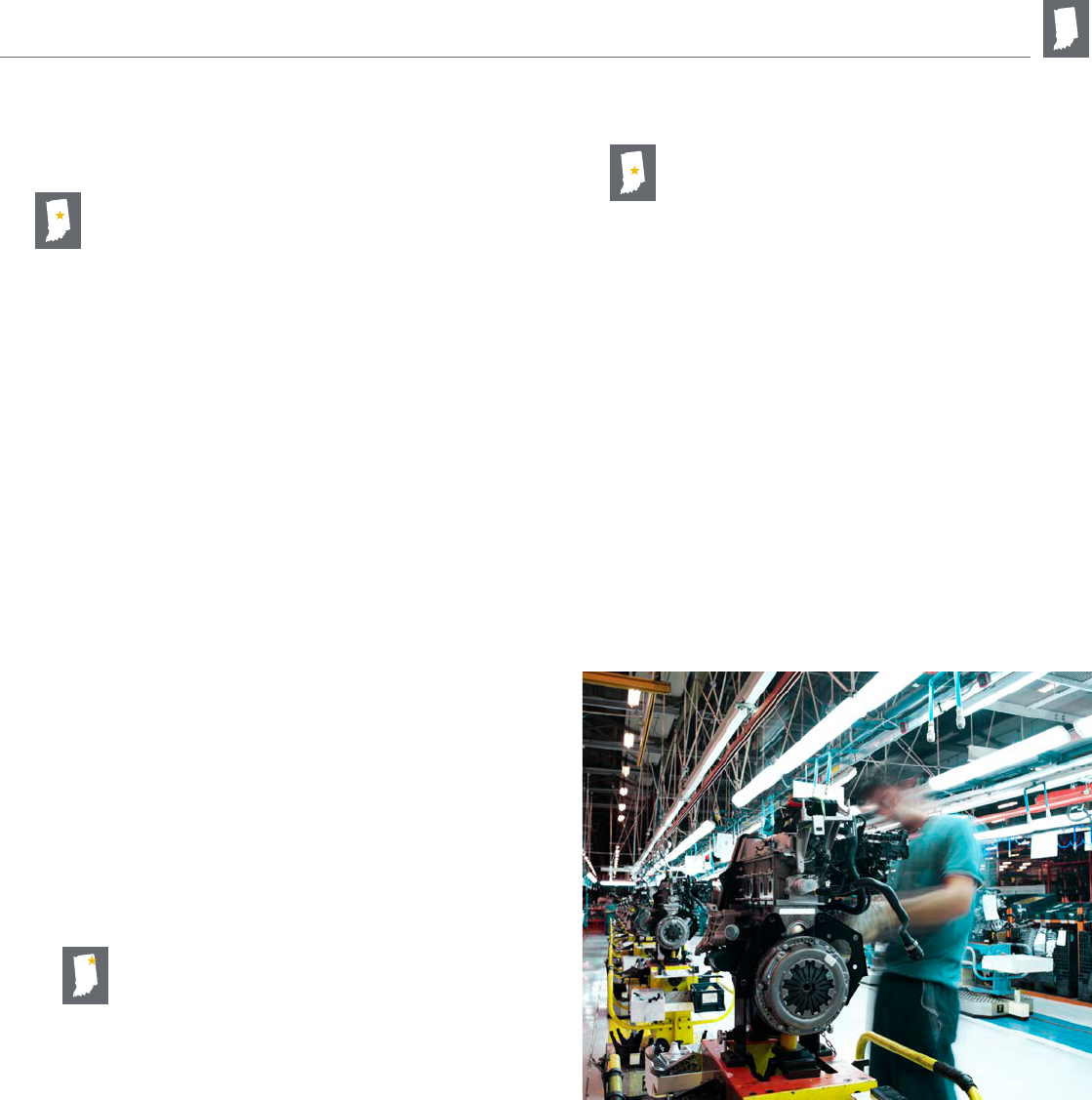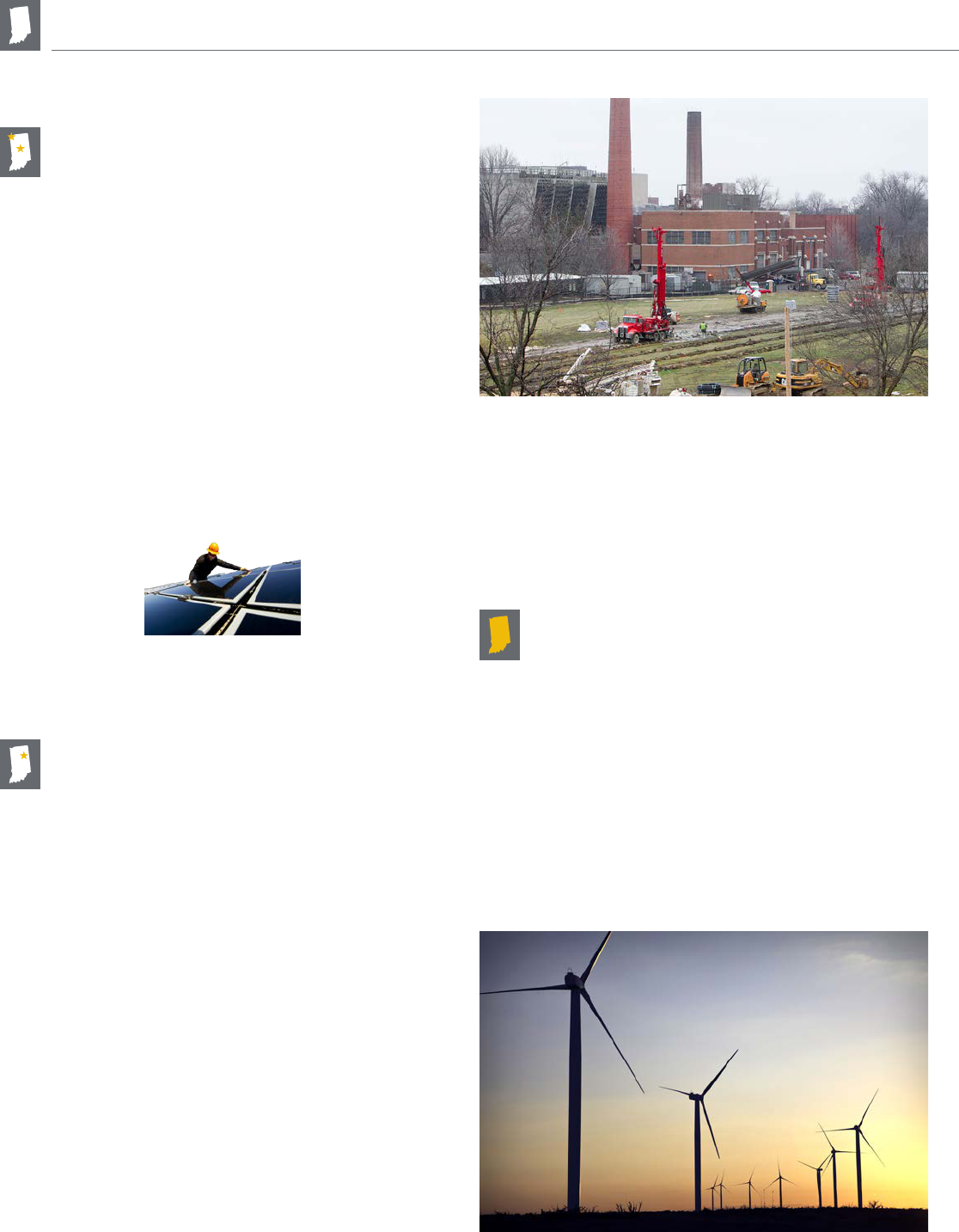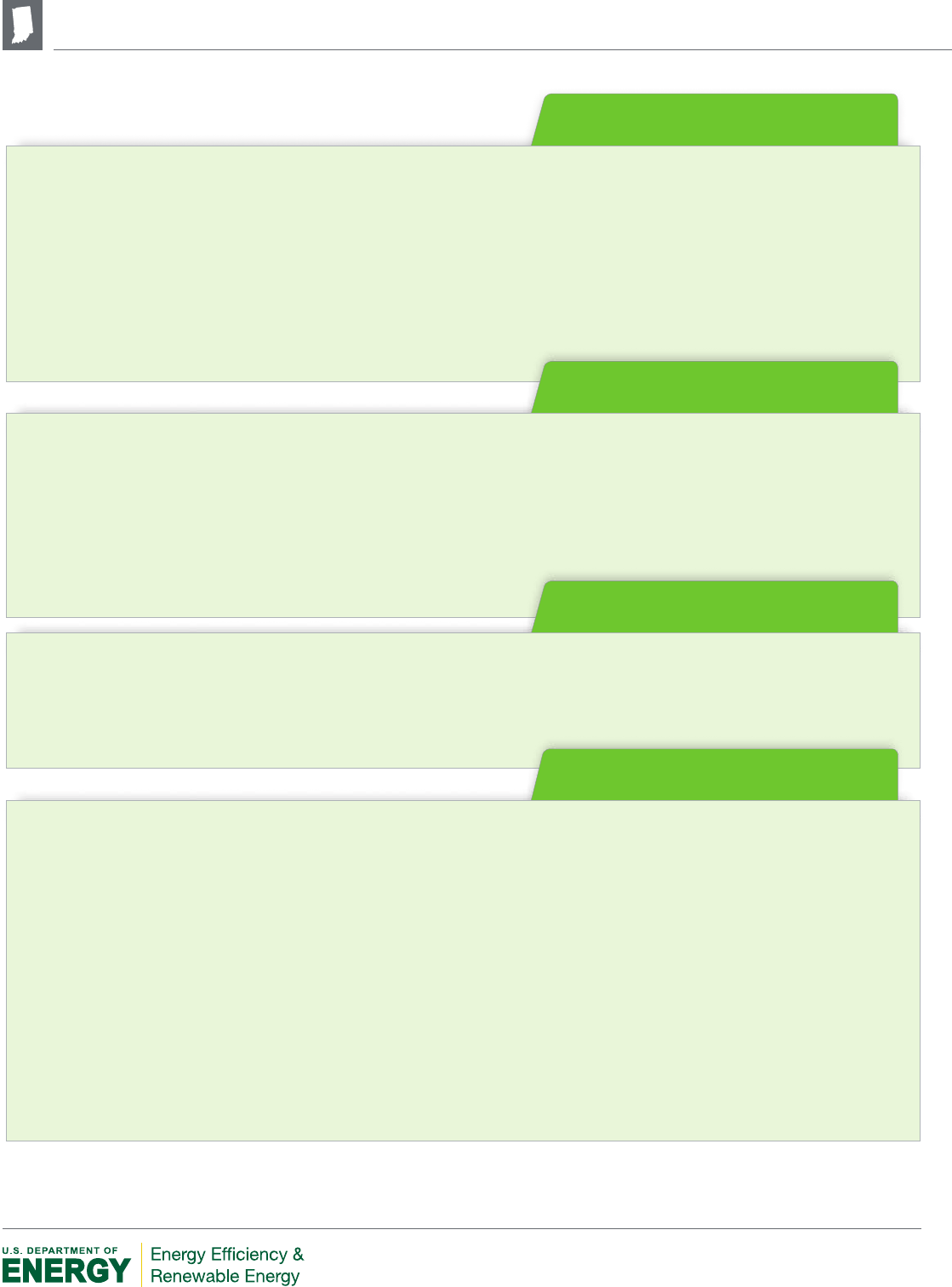
The U.S. Department of Energy (DOE) is pursuing an all-of-
the-above approach to developing every source of American
energy. The Ofce of Energy Efciency and Renewable Energy
(EERE) leads DOE efforts to build a strong clean energy
economy, a strategy that is aimed at reducing our reliance on
foreign oil, saving families and businesses money, creating
middle-class jobs, and reducing pollution.
This strategy will position the United States as the global leader
in clean energy, increasing our nation’s economic competitiveness.
In 2012, $268 billion was invested globally in clean energy, a
500% increase since 2004.
1
Trillions of dollars will be invested
in the coming decades. Clean energy represents one of the most
important economic development races of the 21st century. We
face a stark choice—the clean energy technologies of tomorrow
can be invented and manufactured in Indiana and the rest of
the United States for domestic use and export around the world,
or we can cede global leadership and import those technologies
from China, India, Germany, and elsewhere.
Indiana’s Clean
Energy Resources
and Economy
• CleanEconomyJobs()
• AverageAnnualGrowthRateofClean
EconomyJobs(–)
• AverageAnnualWageofCleanEconomy
Jobs()
Strongincleanenergymanufacturing
renewablesandeciencytechnologies
Indianaranksinthetopthirdofstatesinwind
energypotentialwithacapacityofmorethan
megawatts—enoughtogeneratemore
thanfourtimesthestate’scurrentelectricity
consumption
Thefourutility-scalewind
powerplantscurrentlyoperatinginIndiana
generatemorethanmegawatts—upfrom
virtuallyzeroin
SeveraldozenIndiana
companiesproducecomponentstoolsor
materialsforthewindenergyindustry
Indiana’sautomotivemanufacturingindustry
employedmorethanpeopleand
producedmorethanbillionworthofgoods
in
SeveralofIndiana’sautoandauto
partmanufacturershaveenteredorare
preparingtoenterthegrowingclean
transportationsector
Indianaisoneofstateswithabinding
energysavingstargetTheannualsavings
targetstartsatinandwillrampup
toin
Bythiseortisexpected
tosavemorethanmillionmegawatt
hours—millionworthofelectricity—per
yearstatewide
Indianautilitycompaniesalso
sponsorrebateprogramsforenergy
eciencyandrenewableenergyaswellasa
loanprogramforresidentialenergyeciency
improvements
Indiana
This Indiana State Summary educates policymakers and the public
about EERE investments and their positive impacts in Indiana.
ArcelorMittal USA, Inc. installed an energy-ecient boiler at its Indiana
Harbor Steel Mill that has the capacity to reduce carbon dioxide
emissions by 330,000 tons annually.
Photo from ArcelorMittal

2
Indiana State Summary: EERE Investments in Indiana
EERE and Indiana
EERE helps create Indiana’s clean energy economy today,
developing and delivering innovative, market-driven solutions
for the following:
• Sustainable transportation – making transportation
cleaner and more efcient through solutions that put
electric drive vehicles on the road and replace oil with
clean domestic fuels
• Renewable electricity generation – reducing the cost of
renewable energy through solutions that squeeze more
usable power from sustainable resources and improve
the economics of manufacturing and installation
• Energy-saving homes, buildings, and manufacturing –
developing cost-effective energy-saving solutions that
help make our country run better through increased
efciency—promoting better plants, manufacturing
processes, and products; more efcient new homes and
improved older homes; and other solutions to enhance
the buildings in which we work, shop, and lead our
everyday lives.
EERE Investments in Indiana
EERE invests in Indiana through a broad range of clean
energy projects, including vehicles, geothermal, solar, wind,
and other technologies. Through the research, demonstration,
and deployment activities we conduct with Indiana and its
businesses, universities, nonprots, and local governments,
EERE supports cities, communities, and families to develop
innovative, cost-effective clean energy solutions.
Sustainable
Transportation
Largest U.S. Hybrid Electric Vehicle Supplier Expands
Manufacturing Facility to Create Jobs and Invigorate
Local Community
Kokomo, Indiana
EERE investment: $96.7M
Delphi, the largest North American supplier for hybrid
electric vehicle power electronics components and energy
management systems, is expanding its Kokomo manufac-
turing facility with an EERE investment of $89.3 million.
Delphi has already created more than 198 direct jobs, and
expects the expansion to create more than 900 direct and
indirect jobs.
9
EERE provided Delphi an additional $7.4
million in January 2010, which the company also matched,
to develop a novel low-temperature combustion system for
light-duty vehicles that could improve fuel economy by at
least 25%.
10
In addition, in June 2012, Delphi competed
and was selected for funds through EERE’s Innovative
Manufacturing Initiative for the development of lasers to
be used in a new production process for fuel injectors. This
new process is expected to yield energy savings of up to 25%
relative to current practices.
11
Hybrid Electric Drive Systems Come to the Commercial
Truck Market
Indianapolis, Indiana
EERE investment: $62.8M
EERE’s investment in Allison Transmission, combined with
the company’s matching $62.8 million investment, will fund
the retooling of a facility in Indianapolis for subassembly and
testing of its H3000 hybrid drive systems for the commercial
truck market. Allison estimates that this electric drive tech-
nology can improve fuel economy by 25%–35% compared to
conventional trucks with internal combustion engines. Since
the end of November 2012, Allison has had the capacity in
place to annually produce 20,000 H3000 hybrid drive systems
for medium- and heavy-duty sized trucks and buses.
12
Allison Transmission, with EERE’s support, is developing electric
drive technology which is estimated to improve fuel economy by
25%–35% for commercial trucks.
Photo from iStock 2312011

3
Indiana State Summary: EERE Investments in Indiana
Leading Automotive Parts Manufacturer Develops
Lower-Cost, Higher Performance Hybrid Electric
Motors and Controls
Pendleton, Indiana
EERE investment: $60.2M
Remy International is a leading global manufacturer and
remanufacturer of automotive parts, including starters,
alternators, and hybrid motors. EERE is partnering with
Remy to develop a standardized platform for lower-cost,
higher-performance hybrid electric motors and controls, as
well as to retool and expand its U.S.-based manufacturing
facilities. By creating a family of standardized electric drive
motors and scaling their production, the company hopes it
will be able to reduce the costs of its products for existing
customers in the automotive and heavy-duty vehicle markets.
The rst phase of the project, which refurbished an existing
facility in Pendleton, is complete and has supported 210 direct
jobs. Remy is also investing $60.2 million in the project.
13
EERE’s SuperTruck Initiative – Improving
the Tractor-Trailers that Bring Goods to Our
Communities
The SuperTruck Initiative is an ongoing collaborative
effort between EERE and private industry that seeks to
revolutionize on-highway commercial transportation by
improving the freight hauling efciency of long-haul Class
8 tractor-trailers by more than 50%. All of the major truck
and diesel engine manufacturers in the United States are
participating in this effort.
• Developing and Demonstrating Technologies that
Improve Engine Efciency
Fort Wayne, Indiana
EERE investment: $31M
Navistar, working in cooperation with DOE’s Lawrence
Livermore National Laboratory and Argonne National
Laboratory, is developing and demonstrating technologies
to improve truck and trailer aerodynamics, combustion
efciency, waste heat recovery, hybridization, idle reduction,
and reduced rolling resistance tires. Navistar, conducting
a majority of the work in Fort Wayne, is investing an
additional $52 million in the project.
14
• Improving Engine Performance
Columbus, Indiana
EERE investment: $53.8M
Cummins, the world’s largest diesel engine manufacturer,
received funds from EERE for work on in two areas:
advanced engine technology and light-duty vehicles.
Cummins’ work on Class 8 heavy-duty trucks includes
the development and demonstration of a highly efcient
and clean diesel engine, an advanced waste heat recovery
system, an aerodynamic Peterbilt tractor and trailer
combination, and a fuel cell auxiliary power unit to reduce
engine idling.
15
Cummins’ work on light-duty vehicles are
to develop a fuel-efcient, low-emissions diesel engine
that is 40% more fuel efcient than conventional gasoline
technology, while meeting 2010 EPA emissions standards.
Cummins contributed $55.3 million to these projects.
These funds will be used to develop a fuel-efcient,
low-emissions diesel engine that is 40% more fuel efcient
than conventional gasoline technology, while meeting 2010
EPA emissions standards.
16
EERE has supported Indiana’s auto and auto part manufacturers
as they enter or prepare to enter the growing clean transportation
sector.
Photo from iStock 10427481

4
Indiana State Summary: EERE Investments in Indiana
Adopting Smart Transportation Solutions
Mooresville and Crown Point, Indiana
EERE investment: $30K anually to each coalition
EERE coordinates a network of nearly 100 Clean Cities
coalitions—self-organized groups of local community,
government, and business stakeholders whose efforts to adopt
smart transportation solutions have displaced more than 4.5
billion gallons of gasoline and diesel since 1993. Indiana is
home to two Clean Cities coalitions: Greater Indiana Clean
Cities and South Shore Clean Cities. In 2011, these two
coalitions reduced fuel consumption by the equivalent of
nearly 18 million U.S. gallons of gasoline and prevented more
than 130,000 tons of greenhouse gas emissions. Together, the
coalitions include more than 350 businesses, local govern-
ments, and other organizations, and work to promote the use
of the more than 500 alternative fuel and charging stations in
Indiana. In 2011, the two coalitions leveraged DOE’s support
to raise more than $14 million from businesses, local govern-
ments, other organizations, and non-DOE grants.
Renewable
Electricity
Generation
Ball State University Completes Largest U.S.
Ground-Source Geothermal System, Saving Millions
in Operating Costs
Muncie, Indiana
EERE investment: $5M
EERE has partnered with Ball State University in Muncie to
install a campus-wide ground-source geothermal heating and
cooling system—currently the nation’s largest. The university
anticipates that this system will help save $2 million annually
in operating costs and cut the university’s carbon footprint
in half. Ball State’s geothermal system will replace four aging
coal-red boilers to provide renewable power that will heat
and cool 47 university buildings, comprising 5.5 million
square feet on the 660-acre campus. The rst half of the
project was completed in March 2012, with the nal half
scheduled for completion in 2014. Nearly every component
of the system was manufactured in the United States, and
Ball State contracted with more than 50 Indiana rms to
complete the project.
17
EERE sponsored Ball State University’s campus-wide geothermal
system, which is expected to save $2 million annually in operating
costs and cut the university’s carbon footprint in half. Here,
geothermal boreholes are dug to install the system next to an
existing coal-fired power plant.
Photo from Ball State
Educating Workers, Consumers, and Students about
Wind Power
Statewide
EERE’s Wind Powering America (WPA) is a nationwide
initiative designed to educate, engage, and enable critical
stakeholders to make informed decisions about how wind
energy contributes to the U.S. electricity supply. In Indiana,
WPA has education and workforce training programs at
Purdue University-Calumet in Hammond and at Ivy Tech
Community College in Lafayette. WPA conducted various
wind resource analysis exercises, developed a small wind
consumer’s guide for the state, and supports school wind
projects at high schools, colleges, and universities in Akron,
Albion, Francesville, Union City, and Upland.
Indiana has the wind energy potential of over 40,000 megawatts,
which is more than four times the state’s current electricity
consumption.
Photo from Iberdrola Renewables, Inc., NREL 16706

5
Indiana State Summary: EERE Investments in Indiana
Energy-Saving
Homes, Buildings,
and Manufacturing
Steel Mill Powered by Waste Heat Recovery System
Improves Competitiveness
East Chicago, Indiana
EERE investment: $31.6M
EERE worked with ArcelorMittal USA, Inc. to install an
efcient recovery boiler to use waste heat generated during
iron‐making operations to produce electricity and steam
onsite at the company’s Indiana Harbor Steel Mill in East
Chicago, Indiana. The steam is being used to drive existing
turbogenerators onsite, creating enough electricity to power
the equivalent of 30,000 households each year and reducing
carbon dioxide emissions by 330,000 tons annually, which
is equivalent to removing approximately 60,800 cars from
the road. The project is estimated to have created 360 jobs
related to the design and manufacture of the equipment alone;
employ 200 local construction workers; and, by reducing
energy costs, help support 5,900 jobs associated with the mill.
18
Deploying Clean Energy Solutions
in Indiana Communities
EERE invests in the deployment of energy efciency and
renewable energy projects in communities across the Hoosier
State, catalyzing economic development, creating jobs, gener-
ating clean energy, and reducing utility bills. Of the more
than $249 million in American Recovery and Reinvestment
Act (ARRA) funds allotted to the State of Indiana from
EERE specically for deployment projects, more than
99% has been spent as of March 2013 through the Energy
Efciency and Conservation Block Grant Program, State
Energy Program, and Weatherization Assistance Program.
Building Clean Energy Infrastructure
With nancial and technical support from EERE, energy
ofcials at the state level and in 34 communities have selected
and overseen the completion of hundreds of projects that are
delivering the benets of clean energy to citizens throughout
Indiana. EERE allocated $116 million in ARRA funds to
support activities that
• Increased energy efciency and cost savings of nearly
1,000 buildings (more than 20 million square feet)
through building retrots
• Installed approximately 20 renewable energy systems,
with a total capacity of more than 500 kilowatts of
solar energy systems
• Funded nearly 130 workshops, teaching nearly 5,000
people to perform energy audits and install renewable
energy systems
• Installed more than 6,000 energy-efcient streetlights
and more than 3,000 energy-efcient trafc signals.
19
Weatherizing Homes for Lower Income Families
Indiana has spent more than 99% of the more than $133
million in ARRA funds it received to weatherize approxi-
mately 23,000 homes, exceeding its goal. This resulted in
annual energy savings of approximately 700 billion British
thermal units and prevented more than 60,000 metric tons of
carbon pollution, the equivalent of taking more than 12,000
passenger vehicles off the road for a year.
20
The projects have
enabled income-eligible families to save hundreds of dollars
per year on heating and cooling bills by improving their
homes’ energy efciency as well as the health and safety of
home environments.
21
ARRA funds have enabled the state of Indiana to weatherize
approximately 25,000 homes.
Photo from iStock 5392656

6
Indiana State Summary: EERE Investments in Indiana
Deployment Project Examples
in Indiana Communities
City of Carmel Replaces Street Lights and Deploys
Community Wind Turbines
Carmel, Indiana
EERE investment: $633K
The City of Carmel replaced half of its existing street lights
with light-emitting diodes and deploy small wind turbines to
power the city’s sewer treatment plant. In addition to creating
30 jobs and saving energy, the project is leveraging hundreds
of thousands of dollars from state and local sources.
Purdue Develops the U.S. Renewable Energy Workforce
West Lafayette, Indiana
EERE investment: $500K
Purdue University has established a comprehensive wind
energy program with educational and research components.
Funding has helped Purdue develop graduate and undergrad-
uate curricula for energy engineering, focusing on wind energy
and including a wind energy certicate program. This funding
will help develop the U.S. renewable energy workforce.
Indianapolis Harnesses the Sun and Wind to Power
City Infrastructure
Indianapolis, Indiana
EERE investment: $250K
Indianapolis installed a solar photovoltaic system, solar thermal
system, and wind-powered outdoor lighting on the City-County
Building, a 731,119-square-foot downtown landmark.
22
Warrick County Saves Energy and Money through
Efciency Measures
Warrick County, Indiana
EERE investment: $58K
Warrick County retrotted its lighting in the Warrick
County Courthouse and the Warrick County Security
Center. The county has already realized more than $8,000
in energy savings.
23
Metal Halide Lighting Puts Out More Light for
Less Energy
Shelbyville, Indiana
EERE investment: $500K
Ryobi Die Casting USA used this investment, administered
through Indiana’s Conserving Hoosier Industrial Power
program, to replace the high bay xtures in all three of its
manufacturing buildings with Pulse Start Advanced Metal
Halide xtures. These xtures increased lighting on the shop
oor by 300%, while using only 45% of the initial power
input. The Pulse Start xtures were designed and manufac-
tured in Casey, Illinois.
MD Logistics Upgrades Heating, Cooling, Lighting,
and Control Systems
Plaineld, Indiana
EERE investment: $212K
MD Logistics used this investment, also administered
through Indiana’s Conserving Hoosier Industrial Power
grant program, to retrot heating, ventilating, and air
conditioning (HVAC); lighting; and control systems at its
facility. The company replaced three HVAC units with high
efciency units, retrotted eight cooling units with ultraviolet
C lighting, and installed direct digital control systems to
reduce winter heating costs and summer cooling demand.
MD Logistics also had its warehouse lighting upgraded to T5
High Output uorescent xtures with motion sensors to turn
lights off when an area was unoccupied.

7
Indiana State Summary: EERE Investments in Indiana
References
1
“Who’s Winning the Clean Energy Race?” Pew Charitable Trusts, April 2012.
http://www.pewtrusts.org/uploadedFiles/wwwpewtrustsorg/Reports/Clean_Energy/Clean%20
Energy%20Race%20Report%202012.pdf.
2
“Sizing the Clean Economy: The Clean Economy in the State of Indiana.” The Brookings Institution
and Battelle, July 2011. http://www.brookings.edu/~/media/Series/Clean%20Economy/18.pdf.
3
“Wind Resource Potential.” EERE, 2010. http://www.windpoweringamerica.gov/windmaps/
resource_potential.asp.
4
“NREL’s Wind Powering America Team Helps Indiana Develop Wind Resources.” NREL, October
2010. http://www.nrel.gov/docs/fy11osti/48938.pdf.
5
“Annual State Personal Income and Employment” and “Gross Domestic Product by State.” U.S.
Bureau of Economic Analysis, 2012. http://www.bea.gov/iTable/iTable.cfm?reqid=70&step=1&isuri=1
&acrdn=4#reqid=70&step=1&isuri=1; http://www.bea.gov/iTable/iTable.cfm?reqid=70&step=1&isuri=1
&acrdn=1#.
6
“Cause #42693.” Indiana Utility Regulatory Commission, December 2009. http://www.in.gov/iurc/
files/Cause_No._42693.pdf.
7
Assumes savings equal to 2% of 2010 electricity consumption.
8
“Database of State Incentives for Renewables & Eciency,” EERE, 2012. http://www.dsireusa.org/.
9
“Low Cost U.S. Manufacturing of Power Electronics for Electric Drive Vehicles.” Delphi Automotive
Systems, May 2012. http://www1.eere.energy.gov/vehiclesandfuels/pdfs/merit_review_2012/
adv_power_electronics/arravt022_ape_grant_2012_p.pdf.
10
“2011 DOE Vehicle Technologies Review: Gasoline Ultra Fuel Ecient Vehicle.” Delphi Automotive
Systems, May 2012. http://www1.eere.energy.gov/vehiclesandfuels/pdfs/merit_review_2012/
adv_combustion/ace064_confer_2012_o.pdf.
11
“Innovative Manufacturing Initiative.” EERE, 2012. http://www5.eere.energy.gov/projects/foa/
project/innovative-manufacturing-initiative.
12
“Electric Drive Component Manufacturing Facilities.” Allison Transmission, May 2011.
http://www1.eere.energy.gov/vehiclesandfuels/pdfs/merit_review_2011/adv_power_electronics/
arravt023_ape_tuttle_2011_p.pdf.
13
“Providing Vehicles OEMs Flexible Scale to Accelerate Adoption of Electric Drive Vehicles.” Remy
International, May 2012. http://www1.eere.energy.gov/vehiclesandfuels/pdfs/merit_review_2012/
adv_power_electronics/arravt025_ape_shives_2012_p.pdf.
14
“SuperTruck – Development and Demonstration of a Fuel- Ecient Class 8 Tractor & Trailer.”
Navistar, May 2012. http://www1.eere.energy.gov/vehiclesandfuels/pdfs/merit_review_2012/
veh_sys_sim/vss064_jadin_2012_o.pdf.
15
“Technology and System Level Demonstration of Highly Ecient and Clean, Diesel Powered Class 8
Trucks.” Cummins, May 2012. http://www1.eere.energy.gov/vehiclesandfuels/pdfs/merit_review_2012/
adv_combustion/ace057_koeberlein_2012_o.pdf.
16
“Recovery Act Announcement.” EERE, January 11, 2010. http://apps1.eere.energy.gov/news/
progress_alerts.cfm/pa_id=284.
17
“EERE Network News.” EERE, April 4, 2012. http://apps1.eere.energy.gov/news/archive.cfm/
pubDate=%7Bd%20%272012-04-04%27%7D.
18
“Steel Manufacturer Proves its ‘Mittal’ by Doing More with Less Energy.” DOE, November 2010.
http://energy.gov/articles/steel-manufacturer-proves-its-mittal-doing-more-less-energy.
19
“Recovery Act and the State Energy Program” and “EECBG Allocations for Indiana.” EERE, 2010.
http://www1.eere.energy.gov/wip/recovery_act_sep.html; http://www1.eere.energy.gov/wip/
eecbg_state_allocations.html.
20
“Greenhouse Gas Equivalencies Calculator.” EPA, 2010. http://www.epa.gov/cleanenergy/energy-
resources/calculator.html.
21
“Residential Energy Consumption Survey.” U.S. Energy Information Administration, 2009.
http://www.eia.gov/consumption/residential/.
22
“Greening of the City-County Building.” City of Indianapolis, 2011. http://www.youtube.com/
watch?v=ayJ5EykSisw.
23
“Indiana Energy Insights.” Indiana Oce of Energy Development, December 8, 2011.
http://indianaenergyinsights.blogspot.com/2011/12/warrick-county-lights-it-up-with-eecbg.html.
24
“Retrospective Benefit-Cost Evaluation of U.S. DOE Vehicle Combustion Engine R&D Investments:
Impacts of a Cluster of Energy Technologies.” DOE, May 2010.
http://www1.eere.energy.gov/analysis/pdfs/advanced_combustion_report.pdf.
25
“Retrospective Benefit-Cost Evaluation of DOE Investment in Photovoltaic Energy Systems.” DOE,
August 2010.
http://www1.eere.energy.gov/analysis/pdfs/solar_pv.pdf.
26
“Retrospective Benefit-Cost Evaluation of U.S. DOE Wind Energy R&D Program,” DOE,
June 2010. http://www1.eere.energy.gov/analysis/pdfs/wind_bc_report10-14-10.pdf.
27
National Research Council. Energy Research at DOE: Was It Worth It? Energy Eciency and Fossil
Energy Research 1978 to 2000. Washington, DC: National Academies Press, 2001.
28
“DOE Hydrogen and Fuel Cells Program Record #12020,” DOE, September 27, 2012.
http://hydrogen.energy.gov/pdfs/12020_fuel_cell_system_cost_2012.pdf. Based on projections to
high-volume manufacturing.
29
“Retrospective Benefit –Cost Evaluation of DOE Investment in Photovoltaic Energy Systems.” DOE,
August 2010. http://www1.eere.energy.gov/analysis/pdfs/solar_pv.pdf.
30
“Retrospective Benefit-Cost Evaluation of U.S. DOE Wind Energy R&D Program,” DOE,
June 2010. http://www1.eere.energy.gov/analysis/pdfs/wind_bc_report10-14-10.pdf.
31
“Weatherization Assistance Program.” EERE, May 2009. http://www1.eere.energy.gov/wip/pdfs/
wap_factsheet.pdf.
32
“Building Technologies Program: History and Impacts.” EERE, 2013.
http://www1.eere.energy.gov/buildings/appliance_standards/history_and_impact.html.
33
“Energy Technology Solutions: Public-Private Partnerships Transforming Industry.” EERE, December
2010. http://www1.eere.energy.gov/manufacturing/pdfs/itp_successes.pdf.
34
“Facilitating Cost-Eective Federal Energy Management.” EERE, December 2012.
http://www1.eere.energy.gov/femp/pdfs/femp_fs.pdf.
Page 2: iStock 17393871; page 4: Dennis Schroeder, NREL 19156; page 5: Jim Tetro,
U.S. Department of Energy Solar Decathlon

Indiana State Summary: EERE Investments in Indiana
eere.energy.gov | EE.Communica[email protected].gov
DOE/GO-102013-3791 • March 2013
Printed with a renewable-source ink on
paper containing at least 50% wastepaper,
including 10% post consumer waste.
A Proven Track Record
Snapshot of National Outcomes from EERE Investments
• EERE’s $931 million investment in vehicles combustion engine R&D from 1986 to 2007 achieved a net benefit of $69 billion
(2008 dollars) in fuel savings for users of heavy-duty diesel trucks.
24
• EERE’s $3.7 billion investment in solar photovoltaic R&D from 1975 to 2008 resulted in a net economic benefit of $15 billion
(2008 dollars) due to module eciency and reliability improvements.
25
• EERE’s $1.7 billion investment in wind energy R&D from 1976 to 2008 resulted in a net economic benefit of $8.7 billion
(2008 dollars) due to wind turbine eciency, energy capture, and reliability improvements.
26
• A 2001 National Academy of Sciences analysis found that investments of $1.6 billion in energy eciency R&D in the first two
decades of DOE’s existence from 1978 to 2000 realized a net economic benefit of approximately $30 billion (1999 dollars).
27
• EERE research has helped reduce production costs of automotive lithium-ion batteries by more than 50% since 2008 and is on
track to reach its goal of enabling cost-competitive market entry of plug-in hybrid electric vehicles within the next 10 years.
• EERE’s activities to achieve cost-competitiveness for biofuels have resulted in the recent achievement of reaching a modeled
cellulosic ethanol production cost of $2.15 per gallon of ethanol (or $3.27 per gallon of gasoline equivalent).
• EERE’s eorts have reduced the projected costs of automotive fuel cells (assuming high-volume manufacturing) by more than
35% since 2008 and 80% since 2002—doubling the durability of fuel cells from 950 hours of demonstrated operation in 2006
to more than 2,500 hours of operation on the road.
28
• Without EERE involvement, the average solar photovoltaic (PV) module production cost per watt would have been $5.27 in
2008, rather than $1.92. EERE has accelerated solar industry progress by an estimated 12 years.
29
• Without EERE involvement, cumulative wind power deployment through 2008 would have been less than a third of actual
2008 levels. EERE has accelerated the overall progress of the wind industry by an estimated 6 years.
30
• More than 6,200,000 homes have been weatherized with EERE funding provided to states or leveraged from other sources with
EERE support since 1976—creating an average energy savings of $350 or more per year and avoiding $1.6 billion in energy costs
during winter 2005 alone for all households weatherized.
31
• Due to EERE appliance standards implemented through 2012, a typical household today already saves about $180 per year o its utility
bills. Households can expect to save more than $300 per year by 2030, as they replace their existing appliances with newer models that
use less energy—a cumulative savings to consumers of more than $900 billion by 2020, and more than $1.6 trillion through 2030. The
cumulative energy savings of these standards phased in through 2012 will be about 70 quadrillion British thermal units (quads) of energy
through 2020, and will amount to 120 quads through 2030. (The United States consumes a total of about 100 quads of energy per year.)
32
• EERE and its partners in the manufacturing sector have successfully launched 220 new, energy-ecient technologies, received 78
R&D 100 Awards, and delivered technical assistance to more than 33,000 industrial plants.
33
• Since 2005, EERE has facilitated $3.1 billion of eciency investments in federal government facilities from performance-based
contracts, which will result in energy cost savings of approximately $8.5 billion over the life of the energy-saving measures. The
savings on utility bills and operation and maintenance created through the facility upgrades will be used to pay for the project over
the term of the contract, and the agencies will continue to save money and energy after the contract term has ended.
34
The Oce of Energy Eciency and Renewable Energy is at the center of creating the clean energy economy today. We lead U.S. Department of Energy
eorts to develop and deliver market-driven solutions for renewable electricity generation; sustainable transportation; and energy-saving homes, buildings,
and manufacturing. To learn more about the activities of the Oce of Energy Eciency and Renewable Energy, visit eere.energy.gov. If you have questions
or comments about the information in this document, please contact us at EE.Communications@ee.doe.gov.
EERE’s Return on Investment
for Clean Energy Technologies
Sustainable Transportation
Renewable Electricity Generation
Energy-Saving Homes,
Buildings, and Manufacturing
